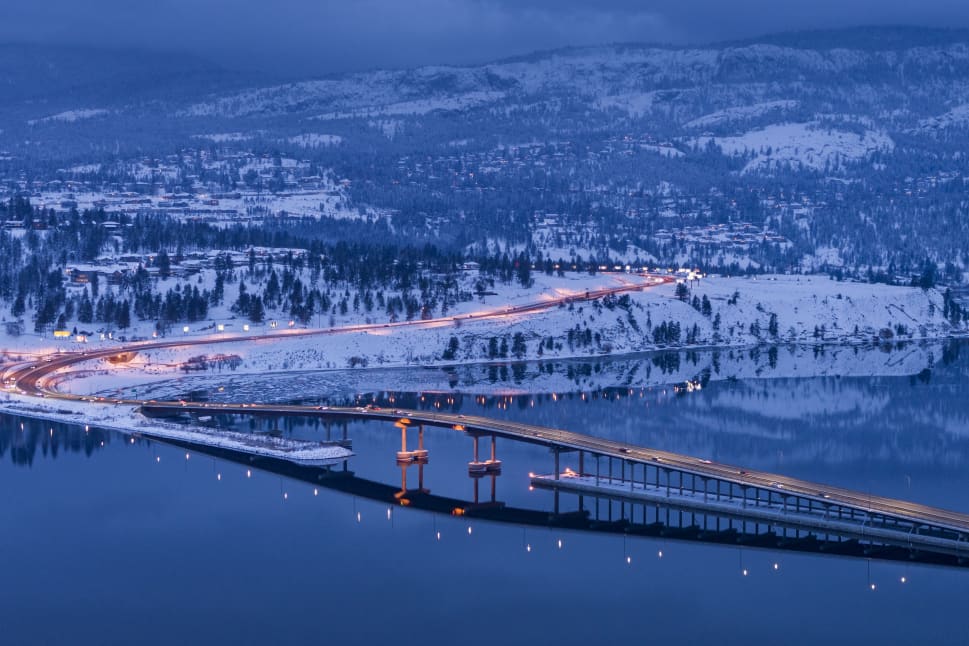Introduction
Two bridges stand out for human ingenuity and the unyielding spirit of progress. The story of Kelowna's lake crossings – the original Okanagan Lake Bridge and its successor, the William R. Bennett Bridge – is not just a tale of concrete and steel. It's a narrative of how these engineering marvels reshaped the city's destiny, knitting together communities and opening gateways to economic prosperity.
The Okanagan Lake Bridge (Kelowna Floating Bridge)
Historical Background
In 1958, a bridge emerged that would redefine Kelowna's landscape and future. The Okanagan Lake Bridge, also known as the Kelowna Floating Bridge, was a pioneering structure in Canadian bridge engineering. Its inauguration by Princess Margaret underscored its significance far beyond Kelowna's borders. This floating bridge not only connected West Kelowna with Kelowna but also marked a new epoch in the region's connectivity.
Engineering and Design
Spanning 650 meters across Okanagan Lake, this floating bridge was a marvel of its time. With a lift span that accommodated taller vessels, it showcased a blend of functionality and innovation. In 1984, adapting to the growing demands of traffic, the bridge underwent a significant transformation, expanding from two lanes to three, with one acting as a counter-flow lane to optimize traffic flow.
Economic and Community Impact
The bridge quickly became a vital transportation link, binding the southern and northern regions of the Okanagan Valley. More than just a physical connector, it was a catalyst for economic growth, funded partly by tolls until 1963. This bridge was instrumental in transitioning Kelowna from a quiet agricultural community to a bustling hub in the Okanagan.
The William R. Bennett Bridge
Historical Background
By 2008, the Okanagan Lake Bridge had outgrown its capacity, paving the way for its successor, the William R. Bennett Bridge. Named in honour of former premier Bill Bennett, a Kelowna native, this bridge was not just a replacement but a symbolic continuation of the region's growth and advancement.
Engineering and Design
The William R. Bennett Bridge is a stunning pontoon bridge, stretching 1,060 meters across the lake. With nine concrete pontoons supporting an elevated deck, it stands out for its modern engineering. The bridge’s design accommodates both traffic and environmental considerations, featuring separate lanes for westbound and eastbound traffic and a pedestrian pathway, all while providing necessary clearance for lake navigation.
Economic and Community Impact
As the new economic lifeline of Kelowna, the William R. Bennett Bridge has been pivotal in supporting the city's burgeoning sectors, including agriculture, tech, and tourism. It played a crucial role in transforming Kelowna's economic landscape, leading to increased housing development and population growth. The bridge not only sustains the flow of goods and people but also represents the city's dynamic growth, with a GDP increasing at a steady rate and projected population expansions.
Comparative Analysis
The original Okanagan Lake Bridge and the William R. Bennett Bridge, though different in structure and era, both represent significant milestones in Kelowna's development. While the former marked the beginning of Kelowna's expansion beyond agriculture, the latter continued this trajectory, accommodating the city’s growing economic and traffic needs. These bridges, each groundbreaking in their time, reflect the city's evolution from a rural settlement to a key player in British Columbia's economy.
Conclusion
Kelowna's two bridges, spanning over half a century of history, are symbols of the city's resilience and ambition, facilitating not just the movement of vehicles but also the flow of ideas, people, and progress. As Kelowna continues to grow, these bridges stand as enduring reminders of the city's journey and its aspirations for the future.





